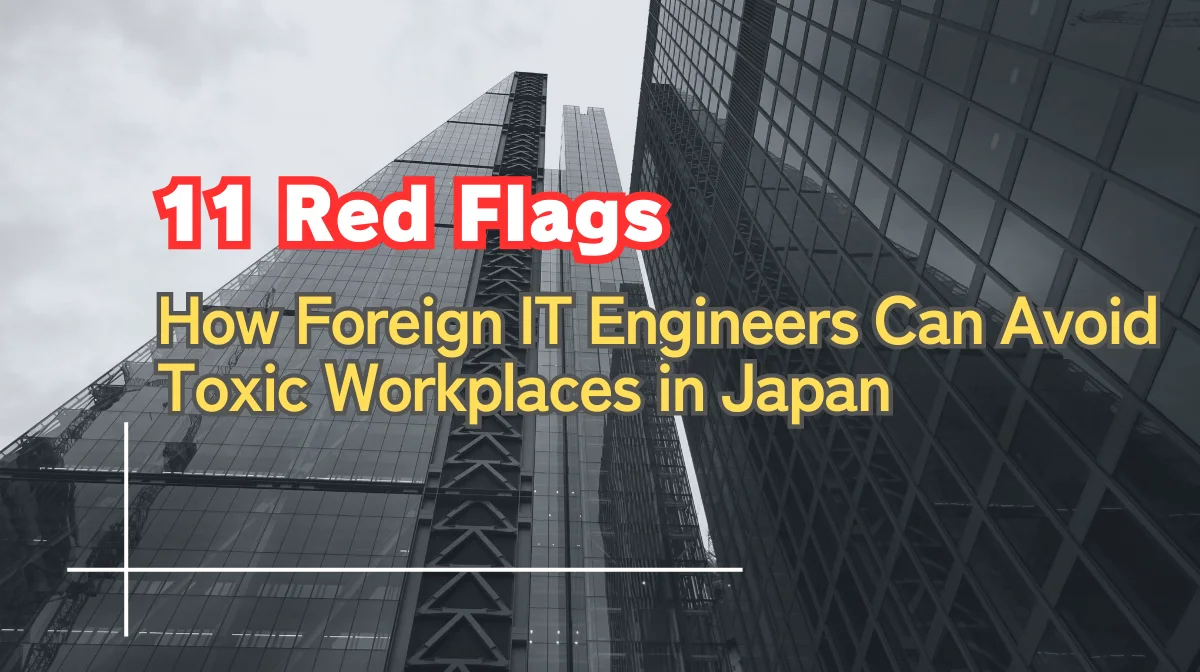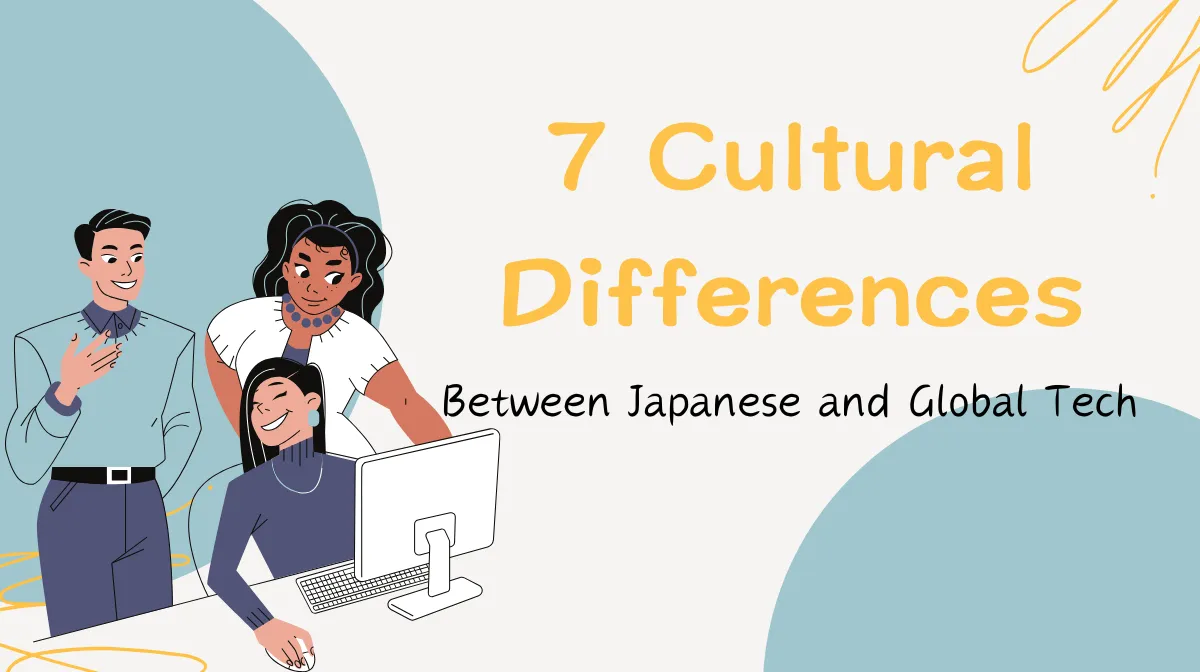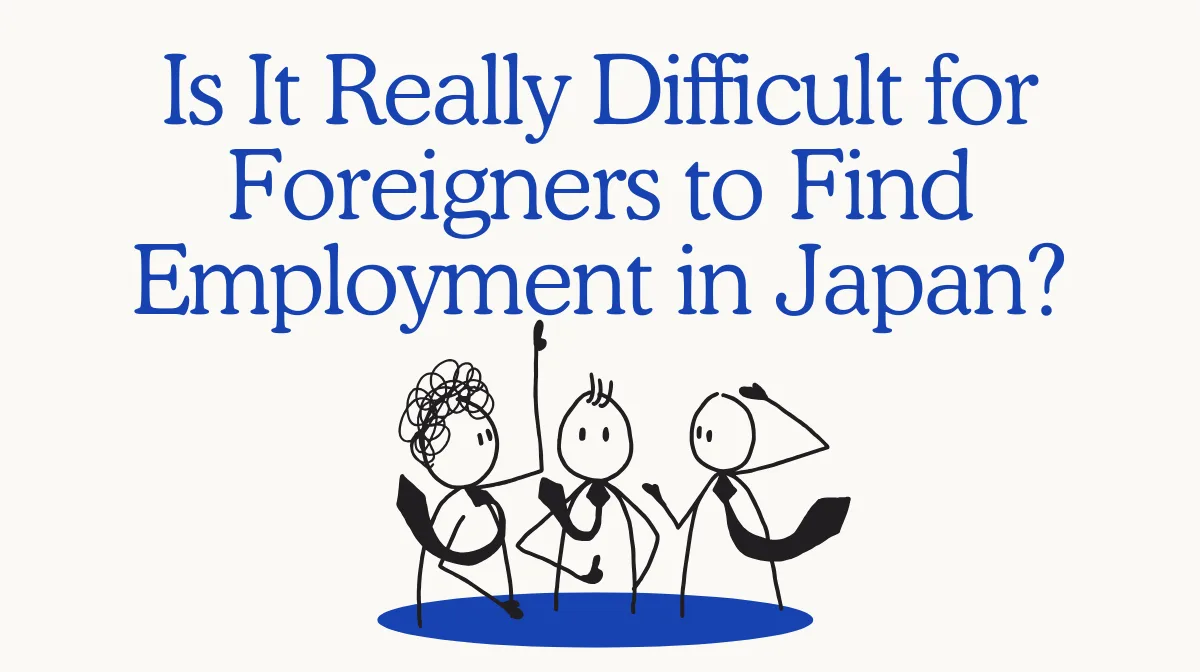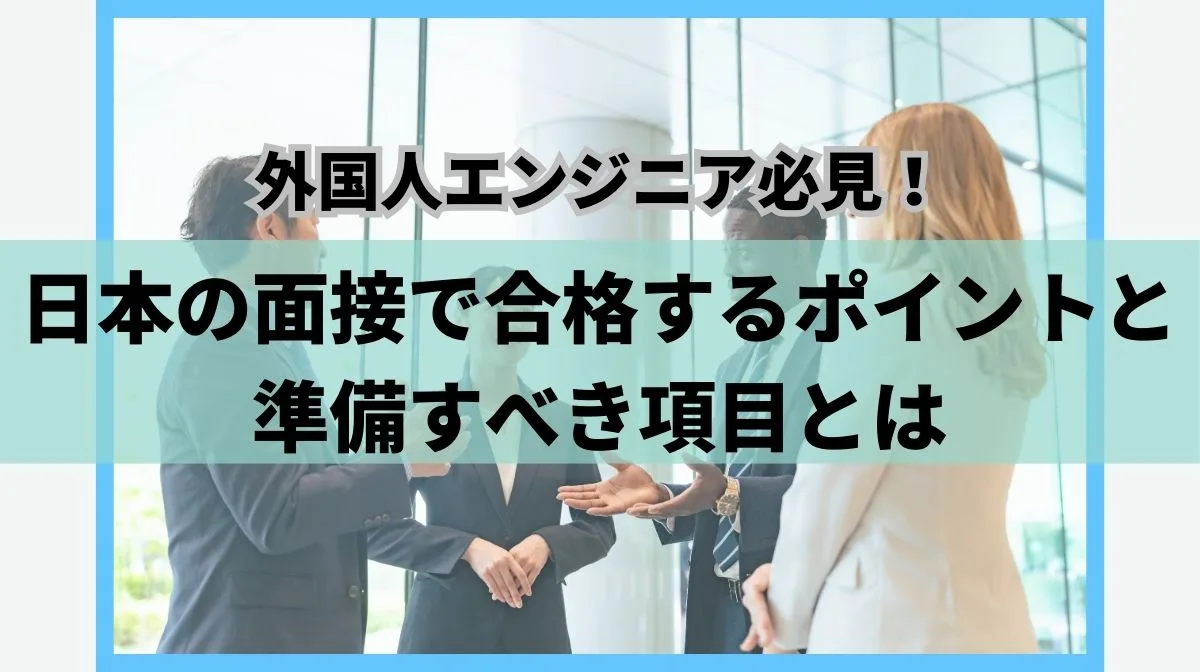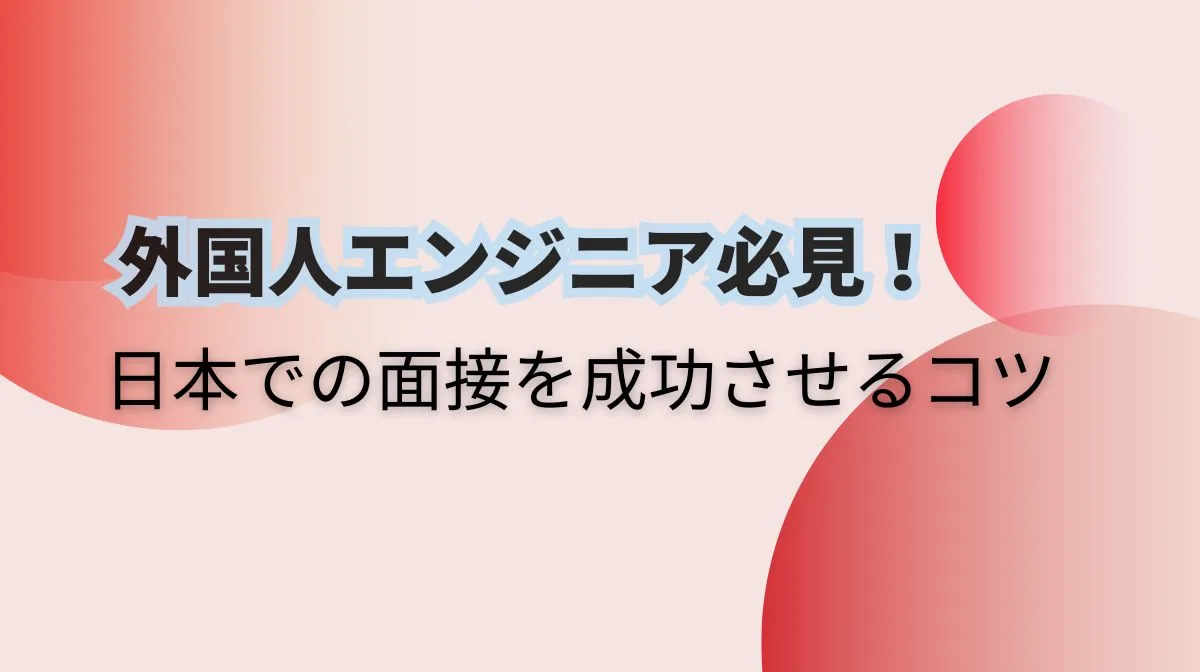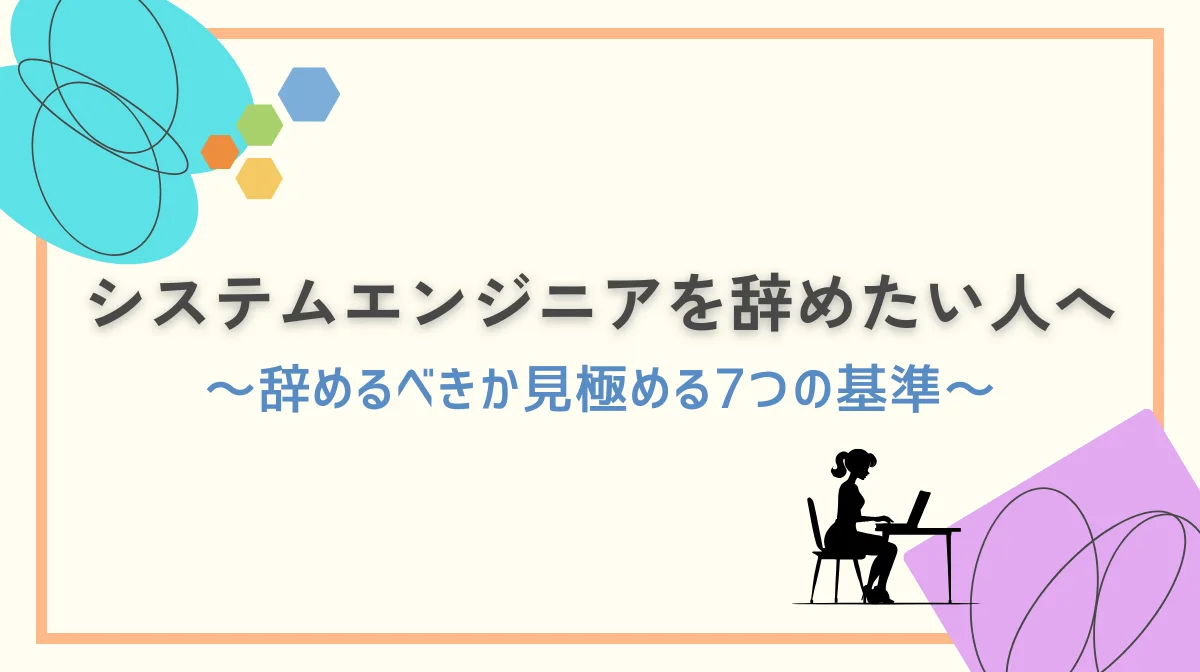Foreign IT engineers working in Japan face unique challenges when identifying problematic employers. Understanding toxic workplace characteristics is crucial for career safety and success.
This guide reveals 11 warning signs and provides practical strategies to secure employment with reputable companies.
- How to spot 11 red flags of toxic Japanese workplaces.
- Seven methods to screen employers during job searches.
- Five traits that identify healthy IT workplaces.
1. Understanding Toxic Workplace Characteristics in Japan

Toxic workplaces exploit workers through excessive demands and illegal practices. The term “black company” (ブラック企業) emerged in the 2000s from online discussions among IT workers sharing their negative experiences.
The Ministry of Health, Labour and Welfare identifies three core toxic workplace characteristics
- Imposing unreasonable working hours and impossible quotas
- Ignoring labor laws regarding overtime pay and workplace harassment
- Treating employees as disposable resources
Since 2019, Japan has enforced stricter overtime limits of 45 hours monthly and 360 hours annually. Companies exceeding these limits face legal penalties, yet many toxic workplaces continue violating these regulations.
The key difference between demanding workplaces and toxic companies lies in respect for human rights. Legitimate busy companies compensate fairly and maintain positive work cultures, while toxic workplaces normalize exploitation and create harmful environments.
■Related Reading
Understanding Japanese workplace culture is essential for recognizing when practices cross from demanding to toxic.
2. 11 Critical Toxic Workplace Red Flags for Foreign IT Engineers
Foreign IT engineers face specific exploitation risks in Japan’s competitive job market. These 11 characteristics help identify companies that systematically target international workers through unfair practices, legal violations, and discriminatory treatment.
1. Abuse of Fixed Overtime Systems
Many toxic workplaces implement fixed overtime pay systems that disguise unpaid labor. These systems supposedly include predetermined overtime hours in monthly salaries but often become tools for unlimited unpaid work.
Warning signs include fixed overtime exceeding 45 hours monthly or vague overtime policies without specific hour limits. Companies may claim additional overtime beyond fixed amounts requires no compensation.
2. Systematic Overtime Pay Violations
Toxic workplaces frequently manipulate timekeeping systems to avoid paying deserved overtime. They may tamper with time cards, abuse self-reporting systems, or pressure employees into unpaid “service overtime”
Some companies reduce official work hours while maintaining the same workload, forcing employees to complete tasks at home without compensation. This practice severely impacts employee well-being and productivity.
■Related Reading
Learn about your rights regarding overtime and working hours in Japan’s IT industry to protect yourself from exploitation.
3. Restricted Vacation Access and Constant Availability Demands
Legitimate paid leave becomes virtually impossible in toxic workplaces. Even when vacation policies exist on paper, managers reject requests or create hostile environments that discourage time off.
These companies often schedule mandatory meetings on holidays without providing proper compensation for weekend work. Annual holiday totals frequently fall below the legal minimum of 105 days.
4. Discriminatory Treatment of Foreign Workers
Despite Japan’s equal pay for equal work principles, some toxic workplaces systematically underpay foreign employees or delay their promotions unfairly.
Recent government data shows foreign workers earn approximately 80% of their Japanese counterparts’ wages. While some disparity may reflect experience differences, significant gaps often indicate discrimination.
5. Inadequate Visa and Immigration Support
Foreign workers depend on employer assistance for visa renewals and immigration documentation. Toxic workplaces may delay providing necessary paperwork, refuse to issue required documents, or handle immigration matters carelessly.
This negligence puts foreign employees’ legal status at risk and creates dependency relationships that companies exploit for control.
6. Tolerance for Harassment and Discrimination
Toxic workplaces often permit or encourage workplace harassment targeting foreign employees. This includes exploiting language barriers to verbally abuse workers, prohibiting native language use, or creating hostile environments based on nationality.
Such treatment frequently leads to mental health issues, forcing employees to take medical leave or resign entirely.
7. High Turnover Disguised Through Constant Hiring
Companies posting identical job listings for extended periods or conducting massive recruitment drives often experience high employee turnover. While business growth may justify increased hiring, excessive recruitment usually indicates retention problems.
Red Flag Indicators
- Turnover rates exceeding 30% within three years
- Average tenure below two years
- Continuous large-scale hiring without corresponding business growth
8. Language Barriers in Essential Documentation
Professional employers provide employment contracts and workplace policies in employees’ native languages or simplified Japanese. Toxic workplaces deliberately maintain Japanese-only documentation to obscure unfavorable terms.
This practice demonstrates inadequate foreign worker support systems and suggests hidden problematic policies.
9. Manipulated Attendance Tracking
Self-reporting attendance systems become tools for wage theft when companies pressure employees to underreport actual working hours. Discrepancies between computer activity logs and reported hours often reveal systematic manipulation.
10. Inadequate Health and Safety Measures
Japanese law requires companies to provide regular health examinations and occupational health support.
Toxic workplaces may skip mandatory health checkups, lack proper industrial physicians, or treat safety requirements as administrative burdens rather than employee protections.
11. Improper Document Control
Some toxic workplaces illegally retain employees’ residence cards or passports under false pretenses. Japanese immigration law requires individuals to carry their residence cards personally.
Companies demanding document custody often use this control to intimidate or manipulate foreign workers. Always refuse such requests and maintain personal control of immigration documents.
■日本でエンジニアとしてキャリアアップしたい方へ
海外エンジニア転職支援サービス『 Bloomtech Career 』にご相談ください。「英語OK」「ビザサポートあり」「高年収企業」など、外国人エンジニア向けの求人を多数掲載。専任のキャリアアドバイザーが、あなたのスキル・希望に合った最適な日本企業をご紹介します。
▼簡単・無料!30秒で登録完了!まずはお気軽にご連絡ください!
Bloomtech Careerに無料相談してみる
3. 7 Essential Screening Methods During Job Search
Preventing toxic workplace employment requires proactive screening before signing contracts. These seven methods help foreign IT engineers identify problematic employers during recruitment processes and avoid career-damaging decisions.
1. Analyze Overtime Policies and Discretionary Work Systems
Carefully examine job postings mentioning deemed overtime or discretionary work arrangements. Legitimate companies specify exact overtime hour limits and explain how these systems operate fairly.
Suspicious indicators include missing overtime specifications, excessive fixed overtime hours, or vague discretionary work descriptions that could enable exploitation.
2. Research Turnover Rates and Employee Retention
Direct questions about turnover statistics often reveal company culture quality. Professional employers willingly share retention data, while problematic companies avoid or deflect these inquiries.
Companies refusing to discuss turnover rates likely experience significant retention issues that indicate deeper workplace problems.
3. Investigate Technical Culture Through Multiple Channels
Review company technical blogs, GitHub activity, social media presence, and employee review sites for authentic workplace insights. Active technical communities and regular knowledge sharing suggest healthy development environments.
Stagnant technical communication or minimal open-source contributions may indicate under-resourced development teams or poor work-life balance preventing external engagement.
4. Evaluate Interview Focus and Company Messaging
Professional interviews balance compensation discussions with role responsibilities and company culture. Excessive emphasis on “family atmosphere” or “passion over pay” often masks inadequate compensation or exploitative practices.
Companies prioritizing emotional appeals over concrete benefits typically expect employees to accept poor conditions through psychological manipulation.
■Related Reading
Master the interview process and identify red flags during your job search with proven strategies for foreign engineers.
5. Assess Foreign Worker Support Infrastructure
Inquire specifically about Japanese language training programs, visa assistance procedures, and international employee support systems. Comprehensive answers with specific examples indicate genuine commitment to foreign worker success.
Vague promises about “figuring things out later” or minimal support programs suggest inadequate preparation for international hiring.
6. Conduct Office Environment Observations
When possible, visit potential workplaces during different times to assess actual working conditions. Evening office lighting patterns, employee behavior, and workspace organization reveal authentic company culture.
Consistently late-night office activity or stressed employee interactions suggest normalized overwork and poor management practices.
7. Question Technical Infrastructure and Project Management
Ask detailed questions about development processes, technology stacks, and project management methodologies. Professional companies explain their technical approaches clearly and demonstrate organized development practices.
Vague or outdated technical responses often correlate with inefficient processes that create excessive workload and frustrating working conditions.
4. Identifying Healthy Workplaces: 5 Key Characteristics to Look For

Healthy workplaces represent the opposite of toxic workplace culture, prioritizing employee welfare and legal compliance.
These five criteria help distinguish legitimate employers from those exhibiting harmful characteristics.
1. Transparent Labor Practice Disclosure
Reputable companies publish specific overtime statistics, vacation utilization rates, and labor agreement details in recruitment materials and company reports. This transparency demonstrates legal compliance and employee welfare prioritization.
Contrast this with companies hiding basic employment statistics or providing only vague policy descriptions.
2. Flexible Work Arrangement Implementation
Modern professional environments offer remote work options, flexible scheduling, and comprehensive leave policies with documented usage rates. These practices show genuine commitment to work-life balance.
Quality Indicators
- Remote work availability 3+ days weekly
- Flexible hours without restrictive core time requirements
- High actual utilization of available benefits
3. Diverse Workforce and Language Accommodation
Companies with established international employee populations demonstrate proven support systems and inclusive cultures. English-language workplace adoption further indicates commitment to global talent integration.
Diverse technical teams often correlate with innovative thinking and professional growth opportunities that benefit all employees.
4. Active Technical Community Engagement
Professional development support appears through company-sponsored conference attendance, open-source project contributions, technical blog maintenance, and knowledge-sharing initiatives.
These activities indicate companies investing in employee growth rather than treating technical staff as expendable resources.
5. Official Recognition and Certification Programs
Government certifications like Excellent Health Management Corporation status, workplace safety awards, or diversity recognition demonstrate verified commitment to employee welfare.
Recognized Programs Include
- Health and wellness management certifications
- Gender equality promotion awards
- Family-friendly workplace designations
- Safety and occupational health excellence recognition
■Related Reading
Explore the best recruitment resources to find companies that genuinely support foreign engineers in Japan.
■日本でエンジニアとしてキャリアアップしたい方へ
海外エンジニア転職支援サービス『 Bloomtech Career 』にご相談ください。「英語OK」「ビザサポートあり」「高年収企業」など、外国人エンジニア向けの求人を多数掲載。専任のキャリアアドバイザーが、あなたのスキル・希望に合った最適な日本企業をご紹介します。
▼簡単・無料!30秒で登録完了!まずはお気軽にご連絡ください!
Bloomtech Careerに無料相談してみる
5. Protecting Your Career by Avoiding Toxic Workplaces
Recognizing toxic workplace characteristics is essential for foreign IT engineers seeking safe employment in Japan. The 11 warning signs covered in this guide help identify exploitative employers before they can damage your career or legal status.
Success requires active screening through research, direct questioning, and careful evaluation of company culture. By choosing employers that demonstrate transparency, fair treatment, and genuine foreign worker support, international professionals can build rewarding careers while avoiding the significant risks associated with toxic workplaces in Japan’s competitive IT market.

